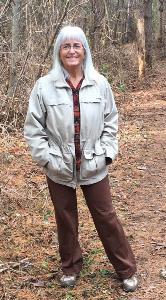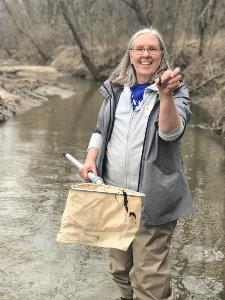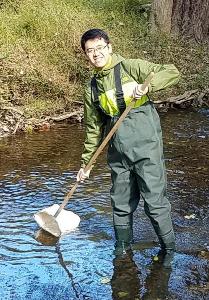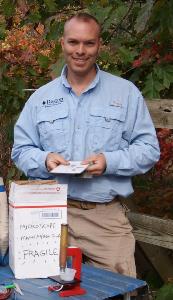If there is one thing that’s clear over the 50-year history of Save Our Streams and volunteer water quality monitoring, it’s that no two stream monitors are exactly alike. They come from different backgrounds – some science-based, most not. They have their own reasons for monitoring water quality, from a love of hunting and fishing to wanting clean water to drink and safe streams for their kids to splash through. Some even monitor water quality as part of their jobs.
We asked Kris Millgate to interview four people who represent a broad range of stream monitors to find out how they got involved – and what keeps them going. Some are seasoned veterans. Others have just begun their journeys. All share a love of our streams and rivers and a passion for keeping them safe. They also show us that no matter our age or background, each of us can make a difference to Save Our Streams.
— Samantha Briggs, acting IWLA Clean Water Program Director
The Beginner
It’s a crisp spring morning. There’s a skiff of white snow crusting brown earth along the stream banks. A handful of volunteers, bundled in beanies and boots, are looking for bugs in the water.
“We have to identify macroinvertebrates,” says Julie Roenigk, Save Our Streams volunteer.
Julie learned how to spot these small insects and other critters living in local streams during a League workshop. Two months later, Julie and other members of the Rochester Chapter in Minnesota were identifying insects, performing simple chemical tests, and taking notes about stream characteristics such as water depth and flow.
The Rochester Chapter has two stream monitoring groups. One group tests water quality in Cascade Creek, which runs through parks and neighborhoods in the heart of Rochester. The other group monitors Silver Creek, which starts northeast of Rochester before running through a nature center and into the city. Both creeks drain into the Zumbro River. More important to the people of Rochester, the Zumbro is a tributary of the Mississippi River. It’s Rochester’s contribution to our nation’s main vein, so protecting it for play now and posterity later matters.
“It has deepened our awareness of this river that goes through our community,” Julie says. “The more you learn, the more know and the more you know, the more you care.”
Julie grew up along the shores of Lake Michigan, where she developed an innate connection to water. She now lives in Minnesota – a state nicknamed the “Land of 10,000 Lakes” – in a county that doesn’t host a single one of those lakes. Life without lakes has been an adjustment.
“Lake Michigan was a huge environmental grounding place for me,” she says. “Every meaningful event in my life included going to Lake Michigan.”
Her husband, Randy, is a Mayo Clinic physician. That’s why they raised their family in Minnesota. Julie’s closest retreat was a 27-acre wetland about 2 miles from her house. She regularly took her two children there when they were little, at first pushing them along stroller the paths and later hiking those same paths together. When the kids grew into adults and moved out, Julie went beyond the wetlands to explore nearby rivers.
“I have access to three or four kayaking rivers,” Julie says. “That’s where my journey began with caring more intimately about river water. The joy of being on moving water is different than lakes, that’s for sure. The energy of moving water is very powerful and it keeps drawing me back.”
She joined the Izaak Walton League and was president of the Rochester Chapter for a few years, during which time she organized chapter stream teams and asked League staff to train them as volunteer stream monitors. Momentum increased and other members wanted in the water too, including families. Now these teams are growing and gathering for four-hour stream monitoring events in the spring and fall.
Julie’s favorite parts of stream monitoring include playing tag with kids who come to help. “I would love to see more families on our stream teams,” she says. Everyone on the team feels that connection with the stream they’re monitoring. “I hope it’s going to have an impact on water quality for future generations.”
The Trainer
Susan Heathcote is one of five new Save Our Streams trainers certified by League staff last November. Now she’s training new volunteer stream monitors like Julie.
She loved growing up in small town U.S.A. (Hamilton County, Iowa) with the opportunity to be a “free range” kid. Susan and her six siblings adventured all summer long. “We played in streams and made dams in cow pastures for swimming,” she recalls. “That shaped my feelings about water. You can see life everywhere in small, unnamed streams.”
Susan chose geology over hydrology in college, then went on to work for a petroleum company. She traveled the world before returning to Iowa for (no surprise here) a job focused on water. She led the Iowa Environmental Council’s water program for 22 years. During that time, she learned there’s more to water than water quality. There’s policy, too.
“I learned how complicated water policy is,” she says. “But the reason we solved big problems wasn’t law or policy – it was local people bringing attention to the problem and forcing agencies to do something.”
Today, she helps people in her community by empowering them with water knowledge. Her policy experience and technical background are a bonus, not a requirement, so she’s an asset when advocating for local streams, which often requires persistence.
“If you identify a problem and people tell you to go away, don’t go away,” Susan says. “Find a way. Get connected with people who will help you with the mechanism to make change. If you’re persistent, you will be successful.”
Susan is a member of an IWLA chapter that’s witnessing stream success. Members of the Des Moines Chapter help monitor water quality in Yeader Creek through the Polk County Water Monitoring Snapshot, which has monitoring data on file back to the late 1980s. The creek’s headwaters are at Des Moines International Airport. Deicing chemicals and runway runoff frequently filled the waterway, and records show no life in the creek for nearly four decades. Improved storm water controls reduced runoff from the airport over time, and adding riffles helped improve creek conditions. Last year, Yeader Creek came back from the dead (although it’s still listed as impaired). Susan and crew collected mayflies there in fall 2018. Bugs are back in Yeader Creek.
“We had a celebration right there on the creek,” she says. “We can make a difference, but the story here is it takes time. It took us 30 years to get where we are today. Volunteers need to understand that. They have to stick with it.”
The Partner
Yishen Li has a master’s degree in water management and works doing research for the Environmental Protection Agency. But his interest in clean water goes back much further.
Yishen grew up in Jinan, an industrial city in eastern China. Despite the development needed to house, feed, and employ
7.5 million residents, more than 100 natural springs still hold a significant place in the city. Across Jinan, artesian springs flow through historic moats into a lake blooming with lotus flowers.
“We have an interesting scene,” Yishen says of his home town. “There’s bustling commerce on one side and the other side is crystal clear springs flowing into old town. People rely on these springs as a source of tourism and identity.”
Yishen remembers when the springs dried up in the 1980s and 1990s and the city lost its spirit. The flows eventually returned, but those dry years were the turning point in his awareness of human-environmental interaction. That’s why, in addition to pursuing a career in water management, Yishen became a stream monitoring volunteer.
“I believe in local engagement and learning about the watershed I live in,” he says. “Water quality protection and community science have always been my passions, and this is a good way to translate my background into a cause I care about.”
Yishen volunteers with a group from the Audubon Naturalist Society to monitor the health of Rock Creek, which drains into the Potomac River – the source of drinking water for millions of people living in Washington, DC, and the surrounding area.
“My favorite thing about monitoring is explaining environmental principles and the importance of healthy waterways to people who do not have an environmental background,” he says. He stands in shin-deep water with accountants, school board members, and reporters, and they’re all looking for bugs. The kind of bugs that mean life – and food for the trout that also rely on Rock Creek.
“If you want to protect something, you have to know what condition it’s in,” Yishen says. “Monitoring is crucial. It tells you what you’re starting with and identifies action. It doesn’t cost you a cent to see if there is a midge in the water, as long as you have the basic equipment and knowledge to look for bugs like that.”
The Professional
Stream monitoring is a neighborhood affair for William Peterson. He’s the watershed specialist for Reston Association, the homeowners association in a planned community of more than 60,000 residents. Will manages four man-made lakes and 20 miles of streams across this rapidly-developing Virginia suburb outside Washington, DC.
The people living in Reston are not there by accident. More than 450 boats, kayaks, and canoes float on community waters. These water resources are a critical part of the neighborhood’s character. That’s why Will knows he’ll have helpers when he needs to do the next bug count. The Reston Association monitors water quality at 11 sites across the community. Will has volunteers monitor nine of those sites four times every year. The other two sites are monitored by Will and used to train new volunteers.
“We wouldn’t be able to do 11 sites without volunteers,” Will says. “Having volunteers lets us obtain more information and gives a better snapshot of [water quality in] our community as a whole.”
Volunteers are divided into teams. Some teams are made up of school teachers bringing their students to the water’s edge for outdoor, hands-on class time. Other teams are like the “three Bobs” (three retired men all named Bob). They’re fly fisherman who know that fish eat bugs, so they’re willing to volunteer as stream monitors because the effort benefits their recreation opportunities.
“It’s a bonding experience for the Bobs. I think they invite me along because they want me to carry all the stuff,” Will jokes. “But it does create ties between Reston staff and our residents. It puts us in the stream together instead of just sitting around a table talking.”
The Save Our Streams program in Virginia ranks water quality on a scale of 0 to 12, with 12 being the best water. Reston waters score in the four-to-seven range – not the cleanest, but not the worst either. Reston started collecting stream data in 2000. “If there’s a big impact, data helps us identify it,” Will says. “We may not know what the problem is right away, but we’ll know right away there’s a change.” After a massive stream restoration project, data is trending toward improvement.
Monitors also make note of habitat. Things like the number of trees on the stream bank and size of rocks in the stream are documented right along with the bug count.
“The biggest problem I find with the macroinvertebrate statistic is the count is just based on presence of bugs,” William says. “That fluctuates with seasons and storms and that greatly changes what you find in a stream at one particular time.”
That’s why trends need to be followed over decades, and Will has the volunteers to keep the process going. His volunteers are so well trained that he doesn’t really need to be in the stream with them, but truth be told, he likes to go along any time he can.
“What I enjoy most is just getting out along a stream with them,” he says. “I like the social aspect of getting to know my volunteers while also getting myself out of the office.”